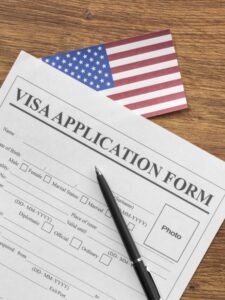Canada has introduced new immigration pathways to attract and retain skilled workers. These pathways provide opportunities for individuals to immigrate to Canada based on their skills and contribute to the country’s economic growth and diversity. Let’s take a look at the new pathways.
Leap Advantage Virtual Spot Offer Event on May 10th 2024

Last call to secure your spot for Masters in US for Fall ’24 Intake
Leap Advantage Virtual Spot Offer Event on May 10th 2024
Last call to secure your spot for Masters in US for Fall ’24 Intake

Canada’s New Immigration Pathways
Digital Nomad Strategy
Canada’s digital nomad strategy is designed to attract remote workers by providing flexible visa options and a high quality of life. The strategy recognizes the growing remote work trend and aims to position Canada as an ideal destination for digital nomads. With its diverse landscapes, strong infrastructure, and welcoming environment, Canada offers nomads the opportunity to work in various industries while enjoying a high standard of living. The strategy focuses on fostering innovation, supporting entrepreneurship, and creating a thriving remote work culture by providing resources, networking opportunities, and access to coworking spaces. Canada aims to become a leading destination for digital nomads seeking a balanced lifestyle and professional growth.
What will the Digital Nomad Strategy offer?
- Employees with an overseas business can stay and work in Canada for up to six months, thanks to the digital nomad strategy. He explained that they could remain in Canada even longer if they were to receive a job offer while there.
- According to Canada’s Ministry of Immigration, Refugees, and Citizenship, the programme will offer H-1B visa holders’ relatives’ study or employment visas.
- The federal government will create an immigration pathway by the end of the year that will allow some of the most talented individuals in the world to immigrate to Canada and work for digital companies, whether or not they already have employment.
International Mobility Program
Developing an Innovation Stream under the International Mobility Program to attract highly talented individuals
- Widening Canada’s talent pool in the sector should remain a goal, as we just heard from stakeholders in the tech industry that there are still labour shortages in important tech jobs.
- In light of this, the Canadian government intends to introduce an Innovation Stream of the International Mobility Programme by the end of 2023. To support Canada’s innovation initiatives and high-tech businesses implies that IRCC will develop a new exclusion from the labour market impact assessment procedure to assist high-growth employers and talented people.
- The Immigration, Refugees and Citizenship Canada (IRCC) are taking into consideration two options that are not mutually exclusive in light of the response from stakeholders on the Innovation Stream proposal:
- Worker-specific work permits for up to five years for those going to companies that the Canadian government has selected as supporting its industrial innovation objectives
- Open work permits may be granted for up to five years for highly trained employees in certain in-demand professions.
Work Permit for H-1B Visa Holders
Improving labour mobility in North America by creating a streamlined work permit for H-1B speciality occupation visa holders in the US to apply to come to Canada
- Many of the thousands of workers in high-tech disciplines employed by multinational corporations with significant operations in Canada and the US have H-1B speciality occupation visas.
- Holders of H-1B speciality occupation visas in the US and any accompanying immediate family members can petition to immigrate to Canada beginning on July 16, 2023.
- Those accepted will be given an open work permit valid for up to three years, allowing them to work for nearly any employer in Canada. Additionally, their spouses and dependents will be qualified to apply for a temporary residence visa with the appropriate employment or study permission.
- This will increase the opportunity for qualified employees to continue pursuing careers in the high-tech industry and support the growth and prosperity of the North American economy.
- Until the IRCC gets 10,000 applications, this provision will be in effect for a year. Only principal applicants will count against the application cap; their accompanying family members will not.
Also Read: Work in Europe for Foreigners
Conclusion
In conclusion, Canada’s new immigration pathways demonstrate the country’s commitment to attracting and retaining skilled workers. Through programs such as Express Entry, Global Talent Stream, Rural and Northern Immigration Pilot, and Atlantic Immigration Pilot, Canada provides diverse opportunities for individuals to immigrate based on their skills and contribute to the country’s economy and cultural fabric. These pathways prioritize factors such as education, work experience, language proficiency, and regional labour market needs. By offering streamlined processes and targeted initiatives, Canada aims to address labour market gaps, foster economic growth, and promote diversity and inclusion. The new immigration pathways reflect Canada’s ongoing efforts to build a strong and vibrant society through skilled immigration.
For more information, visit here.
Frequently Asked Questions (FAQs)
Q. What is Canada’s digital nomad strategy?
Canada’s digital nomad strategy is a set of initiatives and policies to attract remote workers worldwide. It focuses on providing flexible visa options, fostering innovation, and creating a supportive environment for digital nomads to work and live in Canada.
Q. What visa options are available for digital nomads in Canada?
Canada offers several visa options for digital nomads, including the Working Holiday Visa, the International Experience Canada (IEC) program, and the Global Talent Stream. These visas provide opportunities for temporary work and allow digital nomads to experience Canada while pursuing their remote work ventures.
Q. How can I immigrate to Canada?
There are several pathways to immigrate to Canada, including the following popular options:
a. Express Entry: This is a points-based system for skilled workers. It includes the Federal Skilled Worker Program, the Federal Skilled Trades Program, and the Canadian Experience Class.
b. Provincial Nominee Programs (PNPs): Provinces and territories in Canada have their own immigration programs to address specific regional labour market needs.
c. Family sponsorship: Canadian citizens and permanent residents can sponsor family members to immigrate to Canada.
d. Business immigration: Entrepreneurs, investors, and self-employed individuals may have specific immigration programs available.
Q. What are the benefits of working as a digital nomad in Canada?
Working as a digital nomad in Canada offers numerous benefits, such as a high standard of living, access to world-class healthcare, diverse natural landscapes for exploration, a safe and welcoming environment, and opportunities for professional growth and networking in various industries.
Q. How can digital nomads get involved in Canada’s remote work community?
Digital nomads can get involved in Canada’s remote work community by joining local coworking spaces, attending networking events and conferences, participating in online communities, and exploring resources provided by government agencies and organizations supporting remote work initiatives. This allows nomads to connect with like-minded professionals and tap into Canada’s vibrant remote work ecosystem.
Q. What are the language requirements for Canadian immigration?
Language proficiency is an essential requirement for most Canadian immigration programs. The most commonly accepted language tests are the International English Language Testing System (IELTS) for English and the Test d’évaluation de français (TEF) for French. The required language scores may vary depending on the specific immigration program and the level of proficiency desired.
Q. How long does it take to process a Canadian immigration application?
The processing time for Canadian immigration applications depends on various factors, including the type of program and the volume of applications received. Processing times can range from a few months to over a year. It’s important to note that these times can change, and it’s advisable to check the official website of Immigration, Refugees and Citizenship Canada (IRCC) for the most up-to-date processing information.
Q. Can I work in Canada while my immigration application is in progress?
In certain cases, individuals with a valid job offer from a Canadian employer may be eligible to apply for a work permit while their immigration application is being processed. This is typically available through programs such as the Temporary Foreign Worker or International Mobility Program. However, it’s important to note that not all immigration streams allow concurrent work permits, and eligibility requirements may vary. It’s advisable to consult the official IRCC website or seek professional advice to understand the specific options available based on your circumstances.







